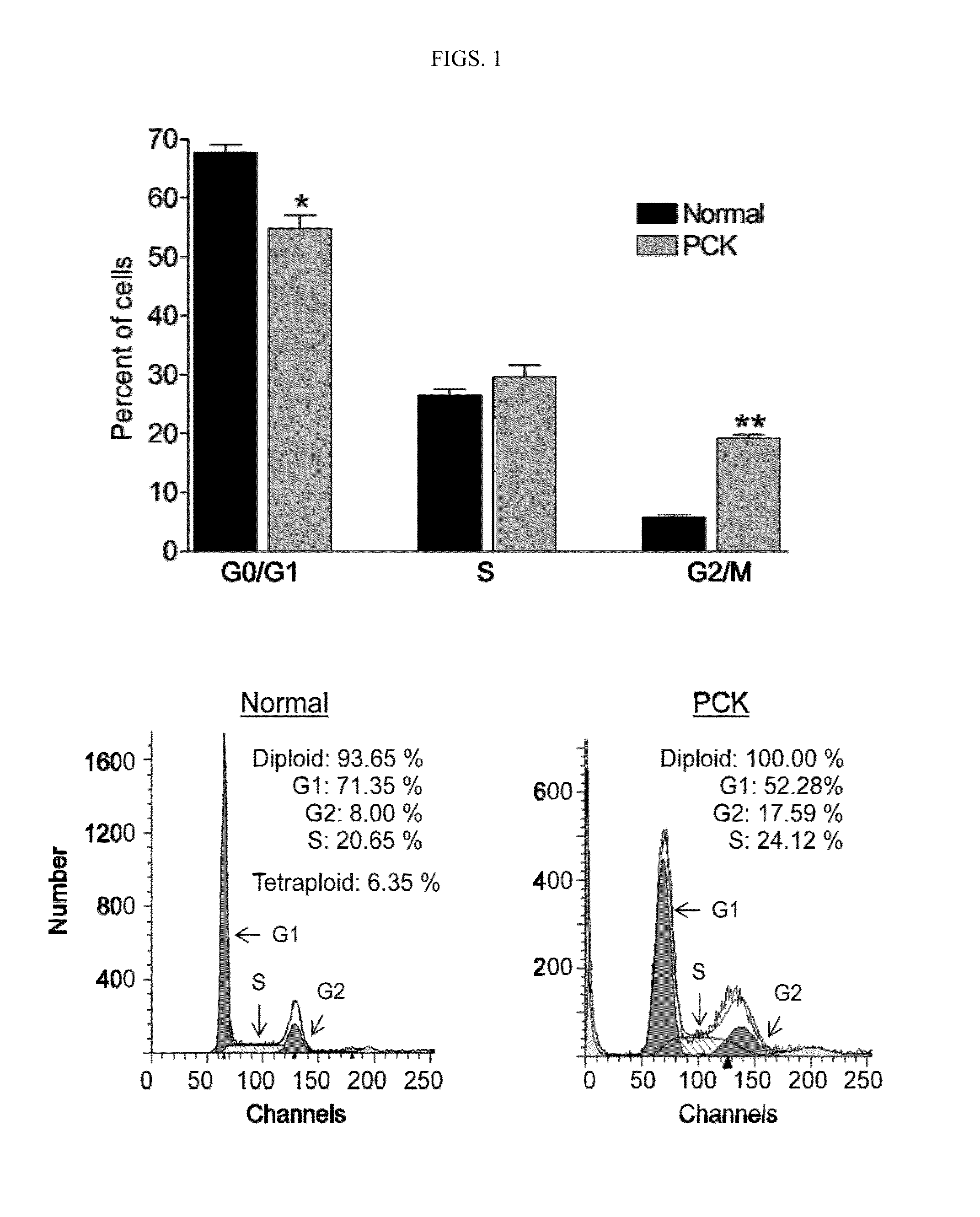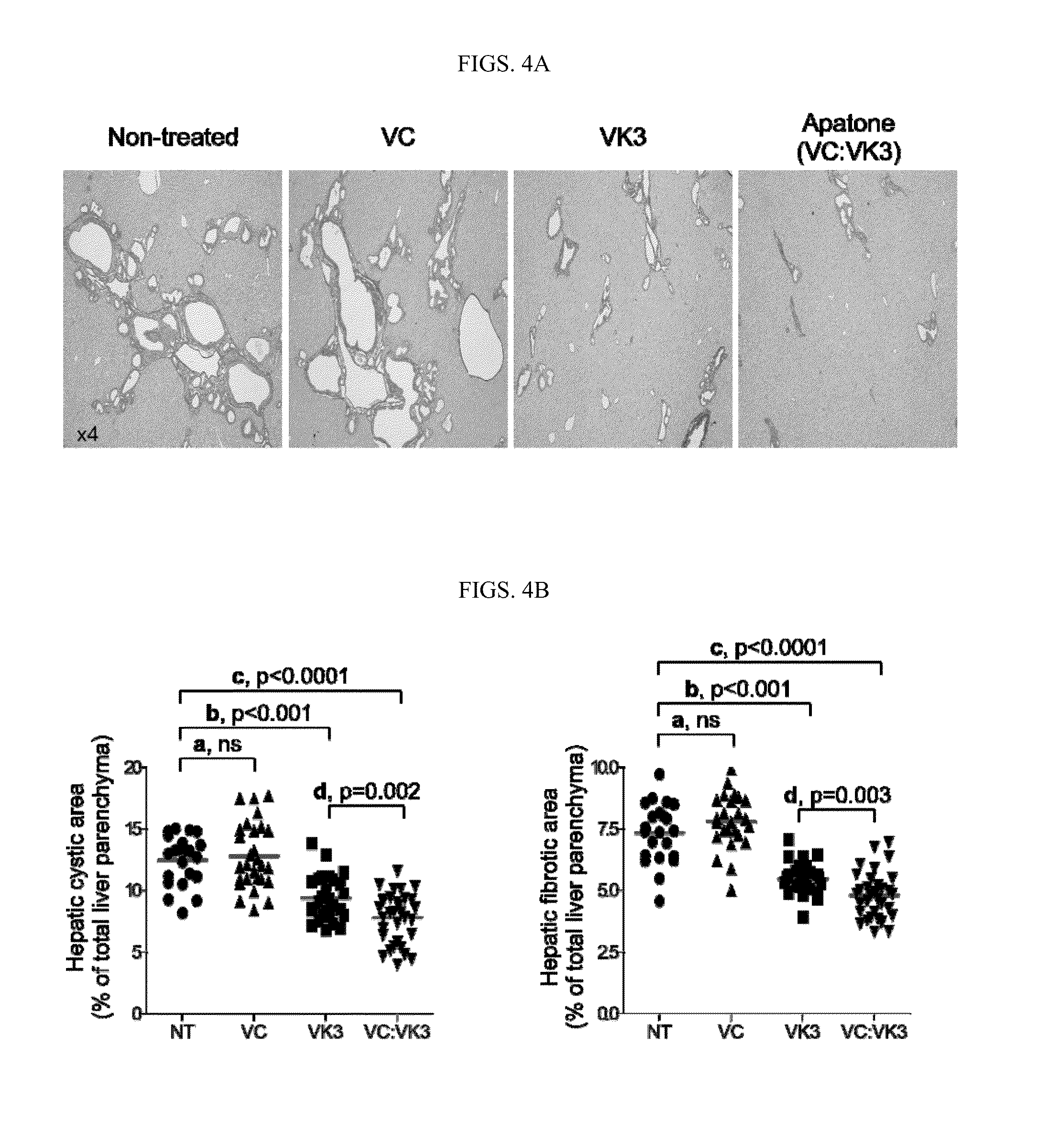Vitamins c and k for treating polycystic diseases
a polycystic disease and vitamin c technology, applied in the field of vitamin c and k for treating polycystic diseases, can solve the problems of renal failure, cysts to develop in the liver and elsewhere in the body, no approved treatment for polycystic diseases to stop cyst growth, etc., to inhibit cystogenesis, inhibit cystogenesis, inhibit cystogenesis
- Summary
- Abstract
- Description
- Claims
- Application Information
AI Technical Summary
Benefits of technology
Problems solved by technology
Method used
Image
Examples
example 1
Comparison of Cystic Cholangiocytes with Normal Cholangiocytes
[0214]In cystic cholangiocytes isolated from an animal model of PLD / PKD, PCK rats, the percent of cells in G0 / G1 phase was reduced, the percent of cells in S phase was not altered, and the percent of cells in G2 / M phase was increased, in comparison with normal cholangiocytes (FIG. 1).
[0215]As shown in FIG. 1A, the majority of cells in normal rat cholangiocytes (n=5) were present in G0 / G1 phase and the percent of cholangiocytes in G2 / M phase was relatively low. In PCK cholangiocytes (n=6), the percent of cells in G0 / G1 phase was decreased, while the percent of cells in G2 / M phase was increased compared to normal. As shown in FIG. 1B, the cultured normal and PCK cholangiocytes were both diploid.
[0216]The rate of proliferation in humans and rodents was also examined by determining proliferating cell nuclear antigen (PCNA) expression. PCNA was overexpressed in cystic cholangiocytes. In normal human, rat, and mouse cholangiocy...
example 2
Treatment of Polycystic Diseases with APATONE®
[0219]Thirty seven PCK rats (20 females and 17 males) at age of 3 weeks were divided into four groups: (i) vitamin C (VC) treatment group: 5 females and 4 males; (ii) vitamin K3 (VK3) treatment group: 5 females and 4 males; (iii) APATONE® treatment group: 6 females and 5 males; and (iv) control group: 4 females and 4 males. Similarly, twenty Pkd2WS25 / − mice (12 females and 8 males) at age of 5 months were divided into four groups: (i) vitamin C (VC) treatment group: 3 females; (ii) vitamin K3 (VK3) treatment group: 2 females and 2 males; (iii) APATONE® treatment group: 4 females and 3 males; and (iv) control group: 3 females and 3 males.
[0220]The VC treatment groups were given vitamin C at a concentration of 15 g / L in drinking water. The VK3 treatment groups were given vitamin K3 at a concentration of 0.15 g / L in drinking water. The APATONE® treatment groups were given vitamins C and K3 at concentrations of 15 g / L and 0.15 g / L, respectiv...
PUM
| Property | Measurement | Unit |
|---|---|---|
| Mass | aaaaa | aaaaa |
| Mass | aaaaa | aaaaa |
Abstract
Description
Claims
Application Information
 Login to View More
Login to View More - R&D
- Intellectual Property
- Life Sciences
- Materials
- Tech Scout
- Unparalleled Data Quality
- Higher Quality Content
- 60% Fewer Hallucinations
Browse by: Latest US Patents, China's latest patents, Technical Efficacy Thesaurus, Application Domain, Technology Topic, Popular Technical Reports.
© 2025 PatSnap. All rights reserved.Legal|Privacy policy|Modern Slavery Act Transparency Statement|Sitemap|About US| Contact US: help@patsnap.com



